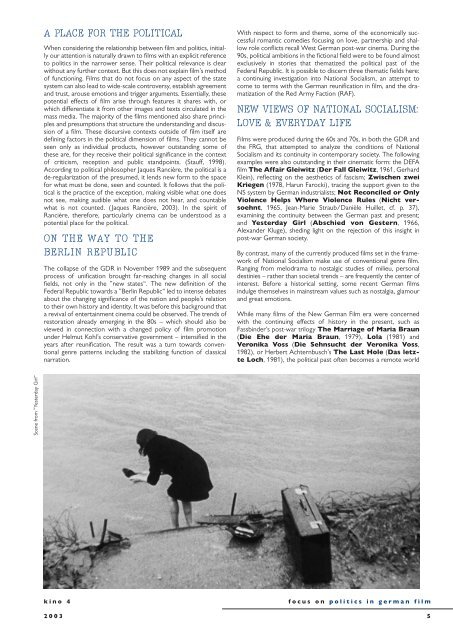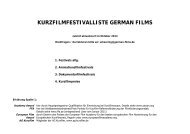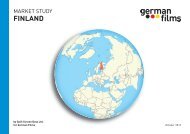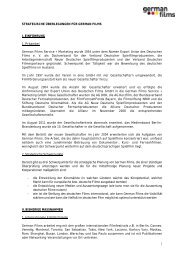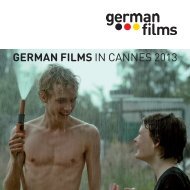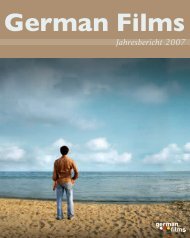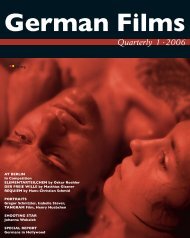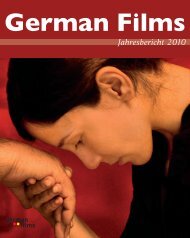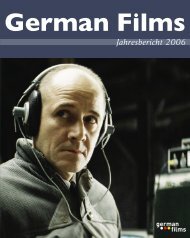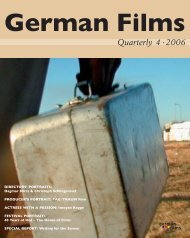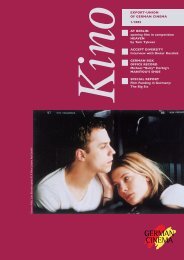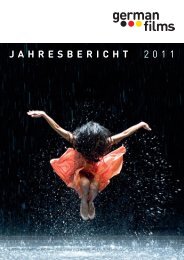Kino - german films
Kino - german films
Kino - german films
Create successful ePaper yourself
Turn your PDF publications into a flip-book with our unique Google optimized e-Paper software.
Scene from ”Yesterday Girl“<br />
A PLACE FOR THE POLITICAL<br />
When considering the relationship between film and politics, initially<br />
our attention is naturally drawn to <strong>films</strong> with an explicit reference<br />
to politics in the narrower sense. Their political relevance is clear<br />
without any further context. But this does not explain film’s method<br />
of functioning. Films that do not focus on any aspect of the state<br />
system can also lead to wide-scale controversy, establish agreement<br />
and trust, arouse emotions and trigger arguments. Essentially, these<br />
potential effects of film arise through features it shares with, or<br />
which differentiate it from other images and texts circulated in the<br />
mass media. The majority of the <strong>films</strong> mentioned also share principles<br />
and presumptions that structure the understanding and discussion<br />
of a film. These discursive contexts outside of film itself are<br />
defining factors in the political dimension of <strong>films</strong>. They cannot be<br />
seen only as individual products, however outstanding some of<br />
these are, for they receive their political significance in the context<br />
of criticism, reception and public standpoints. (Stauff, 1998).<br />
According to political philosopher Jaques Rancière, the political is a<br />
de-regularization of the presumed, it lends new form to the space<br />
for what must be done, seen and counted. It follows that the political<br />
is the practice of the exception, making visible what one does<br />
not see, making audible what one does not hear, and countable<br />
what is not counted. (Jaques Rancière, 2003). In the spirit of<br />
Rancière, therefore, particularly cinema can be understood as a<br />
potential place for the political.<br />
ON THE WAY TO THE<br />
BERLIN REPUBLIC<br />
The collapse of the GDR in November 1989 and the subsequent<br />
process of unification brought far-reaching changes in all social<br />
fields, not only in the ”new states“. The new definition of the<br />
Federal Republic towards a ”Berlin Republic“ led to intense debates<br />
about the changing significance of the nation and people’s relation<br />
to their own history and identity. It was before this background that<br />
a revival of entertainment cinema could be observed. The trends of<br />
restoration already emerging in the 80s – which should also be<br />
viewed in connection with a changed policy of film promotion<br />
under Helmut Kohl’s conservative government – intensified in the<br />
years after reunification. The result was a turn towards conventional<br />
genre patterns including the stabilizing function of classical<br />
narration.<br />
With respect to form and theme, some of the economically successful<br />
romantic comedies focusing on love, partnership and shallow<br />
role conflicts recall West German post-war cinema. During the<br />
90s, political ambitions in the fictional field were to be found almost<br />
exclusively in stories that thematized the political past of the<br />
Federal Republic. It is possible to discern three thematic fields here:<br />
a continuing investigation into National Socialism, an attempt to<br />
come to terms with the German reunification in film, and the dramatization<br />
of the Red Army Faction (RAF).<br />
NEW VIEWS OF NATIONAL SOCIALISM:<br />
LOVE & EVERYDAY LIFE<br />
Films were produced during the 60s and 70s, in both the GDR and<br />
the FRG, that attempted to analyze the conditions of National<br />
Socialism and its continuity in contemporary society. The following<br />
examples were also outstanding in their cinematic form: the DEFA<br />
film The Affair Gleiwitz (Der Fall Gleiwitz, 1961, Gerhard<br />
Klein), reflecting on the aesthetics of fascism; Zwischen zwei<br />
Kriegen (1978, Harun Farocki), tracing the support given to the<br />
NS system by German industrialists; Not Reconciled or Only<br />
Violence Helps Where Violence Rules (Nicht versoehnt,<br />
1965, Jean-Marie Straub/Danièle Huillet, cf. p. 37),<br />
examining the continuity between the German past and present;<br />
and Yesterday Girl (Abschied von Gestern, 1966,<br />
Alexander Kluge), sheding light on the rejection of this insight in<br />
post-war German society.<br />
By contrast, many of the currently produced <strong>films</strong> set in the framework<br />
of National Socialism make use of conventional genre film.<br />
Ranging from melodrama to nostalgic studies of milieu, personal<br />
destinies – rather than societal trends – are frequently the center of<br />
interest. Before a historical setting, some recent German <strong>films</strong><br />
indulge themselves in mainstream values such as nostalgia, glamour<br />
and great emotions.<br />
While many <strong>films</strong> of the New German Film era were concerned<br />
with the continuing effects of history in the present, such as<br />
Fassbinder’s post-war trilogy The Marriage of Maria Braun<br />
(Die Ehe der Maria Braun, 1979), Lola (1981) and<br />
Veronika Voss (Die Sehnsucht der Veronika Voss,<br />
1982), or Herbert Achternbusch’s The Last Hole (Das letzte<br />
Loch, 1981), the political past often becomes a remote world<br />
kino 4 focus on politics in <strong>german</strong> film<br />
2003 5


